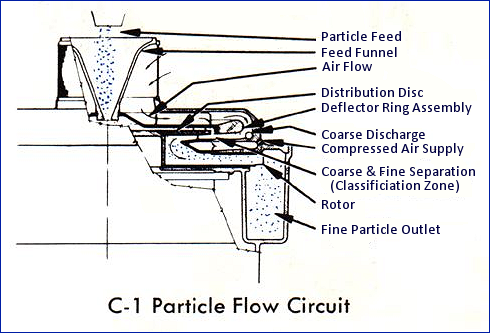 The Vortec C-l Particle Classifier (Separator) is designed to meet the increased technological and scientific requirements for constant optimum particle uniformity in the sub-sieve range. The Vortec C-1 Particle Classifier is the first classifier that can produce narrow particle bands with a maximum deviation of +/- 2 microns.The Vortec C-l Particle Classifier employs a unique tangential, centripetal air flow principle to obtain classification accuracy of +/- 2 microns or better, depending on the material. Rotational motion is applied to each particle and deagglomeration of particles occur as the particles move through the “distribution disc” and “deflector ring.” The particles enter the “classification zone”. For the larger particles, the mass will dominate and it will be discharged through the “coarse discharge” ports. For the smaller particles, the particle’s surface area will dominate and it will be carried by the air flow toward the “fine particle outlet.” There will be one particle size that will be equally likely to be found in the coarse and fine product. This is called the separation point. Separation points are varied by changing the air flow through the classification zone with the stepless dial control or by changing the rotation speed of the rotor assembly. Separation points for a given material are established by calibration.
The Vortec C-l Particle Classifier (Separator) is designed to meet the increased technological and scientific requirements for constant optimum particle uniformity in the sub-sieve range. The Vortec C-1 Particle Classifier is the first classifier that can produce narrow particle bands with a maximum deviation of +/- 2 microns.The Vortec C-l Particle Classifier employs a unique tangential, centripetal air flow principle to obtain classification accuracy of +/- 2 microns or better, depending on the material. Rotational motion is applied to each particle and deagglomeration of particles occur as the particles move through the “distribution disc” and “deflector ring.” The particles enter the “classification zone”. For the larger particles, the mass will dominate and it will be discharged through the “coarse discharge” ports. For the smaller particles, the particle’s surface area will dominate and it will be carried by the air flow toward the “fine particle outlet.” There will be one particle size that will be equally likely to be found in the coarse and fine product. This is called the separation point. Separation points are varied by changing the air flow through the classification zone with the stepless dial control or by changing the rotation speed of the rotor assembly. Separation points for a given material are established by calibration.
The capacity of the Vortec C-1 Particle Classifier is a function of the air flow and the material’s density moving through the unit. Therefore, the capacities vary from approximately 50 pounds per hour, with less dense materials and with the dial control setting for the smallest size particle separation point (minimal air flow), up to 500 pounds per hour with higher density materials and with the maximum size separation point (maximum air flow).
Several configurations of the Vortec C-1 Particle Classifier are available for separation ranges from a minimum of d= 9/(square root of “s”) to a maximum of d = 120/(square root of “s”) ; WHERE: d = particle size in micron, s= particle density in gm/cc.
